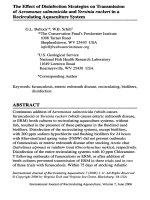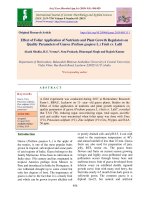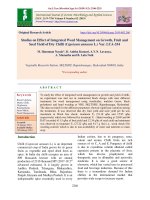Studies on effect of propagation environment for softwood grafting in guava (Psidium guajava L.) cv. Sardar
Bạn đang xem bản rút gọn của tài liệu. Xem và tải ngay bản đầy đủ của tài liệu tại đây (252.55 KB, 5 trang )
Int.J.Curr.Microbiol.App.Sci (2017) 6(6): 2779-2783
International Journal of Current Microbiology and Applied Sciences
ISSN: 2319-7706 Volume 6 Number 6 (2017) pp. 2779-2783
Journal homepage:
Original Research Article
/>
Studies on Effect of Propagation Environment for Softwood Grafting in
Guava (Psidium guajava L.) cv. Sardar
B. Manga*, P. Jholgiker, G.S.K. Swamy, G. Prabhuling and N. Sandhyarani
Department of Fruit science, KRCCH, Arabhavi, University of Horticultural Sciences,
Bagalkot, Karnataka, India
*Corresponding author
ABSTRACT
Keywords
Guava, Mist
house, Poly house,
Shade house,
polytunnel.
Article Info
Accepted:
26 May 2017
Available Online:
10 June 2017
An experiment was conducted to study the on effect of different propagation
environment for softwood grafting in guava cv. Sardar at the Department of Fruit
Science, Kittur Rani Channamma College of Horticulture, Arabhavi, University of
Horticultural Sciences, Bagalkot during the period of October 2012 to January
2013. There was significant difference for graft success and growth of grafts
among different propagation environments. Significantly high graft success and
survival percentage was noticed in mist house eco system (62.00 and 97.40 %,
respectively) followed by shade house (48.00 and 95.00 % respectively). While
minimum graft success and survival percentage was recorded under poly tunnel
(10 and 41.67 %, respectively). Growth parameters like maximum number of
sprouts (4.62) highest length of sprout (6.30 cm) and maximum number of leaves
(21.60) were registered in grafts placed under mist house eco system.
Introduction
Guava is considered as one of the exquisite
and nutritionally valuable fruit crops. It excels
most other fruit crops in productivity,
hardiness, adaptability and nutritive value.
Besides its high nutritive value, it bears heavy
crop every year and gives good economic
returns involving very little input (Singh,
2007). Most of guava plantations in India are
seedling origin. Traditionally, it is mostly
propagated from seed (Zamir et al., 2003).
However, plants raised from seeds are not
true to type and eventually take longer time to
reach to bearing stage. They are also
propagated by layering, however it is
combursome and has limitation for large scale
and rapid multiplication. Softwood grafting,
which is successfully practiced in fruit crops
like mango, sapota cashew, jack fruit with
good response can also be practice in guava.
This method is easy, convenient in handling,
involves simple skill and takes short period.
The most important feature of the method is
that, it allows higher rate of multiplication of
plants and resultant plants will be vigorous.
The propagation environment for grafting is
one of the most important factors which plays
a key role in success of grafting. The year
round fluctuation in temperature, relative
humidity and sunlight results in varying
degree of success in softwood grafting in
2779
Int.J.Curr.Microbiol.App.Sci (2017) 6(6): 2779-2783
guava. Identification of right type of
propagation structure with ideal micro climate
conditions suitable for softwood grafting will
help in rapid multiplication and production of
healthy planting material.
Limited work has been done and reported in
guava with respect to improvement in graft
success by using controlled conditions /
propagation environment. There is a need to
identify
right
type
of
propagation
environment
for
higher
propagation
efficiency.
Therefore,
the
present
investigation was undertaken.
Materials and Methods
An experiment, on studies on effect of
propagation environment for softwood
grafting in guava (Psidium guajava L.) cv.
Sardar was carried out during the period from
October 2012 to December 2012, at the
Department of Fruit Science, Kittur Rani
Channamma College of Horticulture,
Arabhavi, University of Horticultural
Sciences, Bagalkot, Karnataka state. The
experiment was conducted to find out the
influence of propagation environment on
success of softwood grafting in guava. The
experiment was laid out in Randomized Block
Design with 5 treatments and 5 replications.
Softwood wedge grafting was performed in
the month of October. Two fifty grafts were
prepared at the rate of fifty grafts in each
treatment and placed under different
environments viz., open condition, shade
house, poly house, mist house and poly
tunnel.
Root stocks were raised in poly bags from
fresh seeds of guava cv. 'Sardar' extracted
from ripe fruits for approximately 6 to 8
months till they attained a stem diameter of
0.5 to 1.0 cm. The scion shoots (15 to 18 cm
long) of pencil size thickness with 3 to 4
healthy buds were used for grafting. Selected
scion shoots were pre-cured ten days prior to
detachment. Softwood wedge grafting was
performed in the month of October as per
procedure suggested by Amin (1974). The
prepared grafts were covered from top by
polytube cap. This cap was retained on the
graft for one month or till sprouting was
observed on the graft. The observation were
recorded on graft-take i.e. per cent graft
success and survival percentage. The growth
parameters such as number of sprouts, per
cent sprouting, average length of sprout and
average number of leaves were recorded at
30, 60 and 90 days after grafting. The data
was statistical analysed by following
procedure as suggested by Panse and
Sukhatme (1978).
Results and Discussion
The data pertaining to the studies on effect of
different propagation environment on graft
take in softwood grafting of guava cv. Sardar
demonstrated varying degree of success
(Table 1). Interpretation of data indicated
maximum per cent graft success (62.00 %)
was recorded in graft kept under mist house
eco system followed by shade house (48.00
%) and lowest grafting success was recorded
in poly tunnel (10.00 %) at 90 days after
grafting respectively.
Results of data reveal significant differences
for graft survival in different propagation
environment. The significantly maximum
graft survival (97.14 %) was recorded in
grafts placed under mist followed by grafts
under the shade house condition (95.00 %) at
90 DAG, which were at par with each other
(Table 1). The superiority of propagation with
the help of mist house has been well
documented by Muniswami (1979) in cashew,
Raghavendra et al., (2011) in wood apple and
Rajashekar (1999) in sapota. The beneficial
effects of high graft success for softwood
grafting under mist house could be attributed
2780
Int.J.Curr.Microbiol.App.Sci (2017) 6(6): 2779-2783
to availability of high humidity (Fig. 2)
stretched for longer period which prevents
desiccation of the tissues at scion and stock
interface also favours rapid callus tissues
development leading to better graft union
formation.
Similar findings were also reported by Jose
and Valsalakumari (1991) in Jack. Least graft
success and survival was noticed in the
polytunnel. This may be attributed to buildup
of higher temperature under poly tunnel
during graft healing period which might have
lead to faster desiccation of fragile callus cells
as these parenchymatous cells are thin walled
with no provision for resisting higher
temperature (Fig. 1).
Table.1 Effect of different propagation environment on graft-take and its growth at 90
DAG in softwood grafting of guava cv. Sardar
Propagation
environment
Open conditions
Shade house
Poly house
Mist house
Poly tunnel
SEm±
CD @ 5%
CV (%)
Per cent graft
success
40.00
(39.23)*
48.00
(43.85)
20.00
(26.56)
62.00
(51.94)
10.00
(18.44)
3.00
8.99
18.63
Number
of
sprouts
3.88
3.08
4.40
4.62
2.40
0.11
0.32
6.55
Per cent
sprouting
48.00
(43.85)
50.70
(45.40)
76.80
(61.21)
66.50
(54.63)
55.00
(47.87)
4.98
14.92
18.74
Average
length of
sprout (cm)
Average
number of
leaves
4.76
20.00
4.82
18.00
6.12
20.40
6.30
21.60
5.60
11.60
0.40
1.19
16.01
1.45
4.36
17.74
Survival
percentage
74.07
(59.41)
95.00
(77.08)
40.67
(39.65)
97.14
(80.23)
41.67
(40.23)
6.45
19.33
20.67
DAG – Days after grafting
* Values in parenthesis are angular transformation data
Fig.1 Monthly average temperature (oC) recorded in propagation structures at 8.00 am and
2.00 pm during the period of investigation
2781
Int.J.Curr.Microbiol.App.Sci (2017) 6(6): 2779-2783
Fig.2 Monthly average relative humidity (%) recorded in propagation structures at 8.00 am and
2.00 pm during the period of investigation
The success of graft union and its health can
also be judged on the basis of production of
number of sprouts, per cent sprouting, length
of sprout and number of leaves (Table 1). In
the present investigation the higher rate of
success of graft union under mist house
condition was evidenced by the higher values
for growth parameters. This might be due to
the high relative humidity (Fig. 2) and slightly
inclined temperature prevailing in mist house
ecosystem (Fig. 1).
Similar findings have also been reported by
Jose and Valsakumari (1991) and Dhanraj
(1996) in jackfruit. This trend was also
observed by Kumar and Khan (1988) and
Swami et al., (1990) in cashew, Mulla et al.,
(2011) in Jamun and Rajashekar (1999) in
sapota.
References
Ali, Z. M. and Lazan, H. 1997. Guava In:
Postharvest physiology and storage of
tropical and subtropical fruits. Mitra SK
(ed.) CAB international Willingford,
UK, pp. 145-165.
Amin, R. S. 1974. A study on the
establishment of mango orchard with
wedge graft on in-situ grown mango
seedlings in dry region of Gujarat.
Haryana J. Hort. Sci. 3: 160-167.
Anon. 2011. Area and production of guava.
http//www.nhb.gov.in.
Dhanraj. 1996. Standardization of vegetative
propagation
techniques
of
jack
(Artocarpus heterophyllus L.) using
green house and mist chamber facilities.
M. Sc. (Agri.) Thesis, Univ. Agric. Sci.,
Bangalore.
Kumar, B. Mistry, N. C. Singhm, B. and
Gandhi, C. P. 2011. Indian Horticulture
Database, National Horticulture Board
(NHB), Gurgaon. Department of
Agriculture and & Cooperation, Govt.
of India. Pp. 76-83.
Kumar, D. P. and Khan, M. M. 1988. In situ
softwood grafting in cashew. The
Cashew. 2 (2): 3-4.
Mulla, B. R. Angadi, S. G. Mathad, J. C.
Patil, V. S. and Mummigatti, U. V.
2011. Studies on softwood grafting in
jamun (Syzygium cumini Skeels.).
Karnataka J. Agric. Sci. 24 (3): 366368.
Muniswami, K. P. 1979. Cashew grafts under
mist conditions. Cashew Causerie. 1
(2): 16-20.
Panse, V. G. and Ukhatne, P. V. 1967.
Statistical methods for agricultural
2782
Int.J.Curr.Microbiol.App.Sci (2017) 6(6): 2779-2783
workers, ICAR, New Delhi, pp. 152161.
Raghavendra, V. N. Angadi, S. G. Allolli, T.
B. Venugopal, C. K. Mokashi, A. N.
and Mummigatti, U.V. 2011. Studies on
soft wood grafting in wood apple
(Feronia limonia L.). Karnataka J.
Agric. Sci. 24 (3): 371 – 374.
Rajashekhar, G. 1999. Studies on softwood
grafting in sapota [Manilchara achras
(Mill.) Fosberg] under mist house
condition. M. Sc. (Hort.) Thesis, Univ.
Agric. Sci. Dharwad.
Ruehle, G. D. 1948. A rapid method of
propagating the guava. California
Avocado Society. Yearbook. 33: 108112.
Swami, K. R. M., Singh, R. and Mohan. 1990.
Correlation of success on softwood
grafting in cashew with weather
parameter. South Indian Hort. 38 (6):
297-300.
Valsalakumari, P. K. 1991. Standardization of
the technique of epicotyl and softwood
grafting
in
jack
(Artocarpus
heterophyllus Lam.). South Indian Hort.
39 (5): 264-267.
Verheij, E. W. M. and Coronel, R. E. (eds),
1991. Plant Resources of South-East
Asia No. 2. Edible fruits and nuts.
Backhuys Publishers, Leiden. Pp. 266270.
Zamir, R. Khattak, G. S. S., Mohammad, T.
and Ali, N. 2003. In vitro mutagenesis
in guava (Psidium guajava L.). Pakistan
J. Bot. 35 (5): 825-828.
How to cite this article:
Manga, B., P. Jholgiker, G.S.K. Swamy, G. Prabhuling and Sandhyarani, N. 2017. Studies on
Effect of Propagation Environment for Softwood Grafting in Guava (Psidium guajava L.) cv.
Sardar. Int.J.Curr.Microbiol.App.Sci. 6(6): 2779-2783.
doi: />
2783





![Studies on correlation and path analysis for grain yield and quality components in foxtail millet [Setaria italica (L.) Beauv.]](https://media.store123doc.com/images/document/2020_01/09/medium_dyd1578574836.jpg)
![Effect of post harvest treatments on the shelf life and quality of guava [Psidium guajava (L.)] cv. Allahabad Safeda](https://media.store123doc.com/images/document/2020_01/14/medium_wgi1578938512.jpg)


